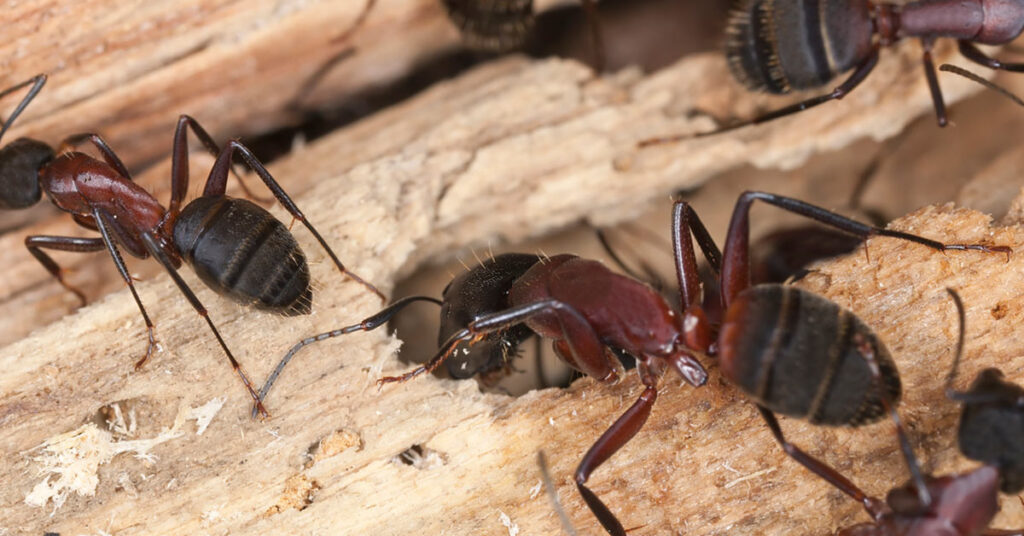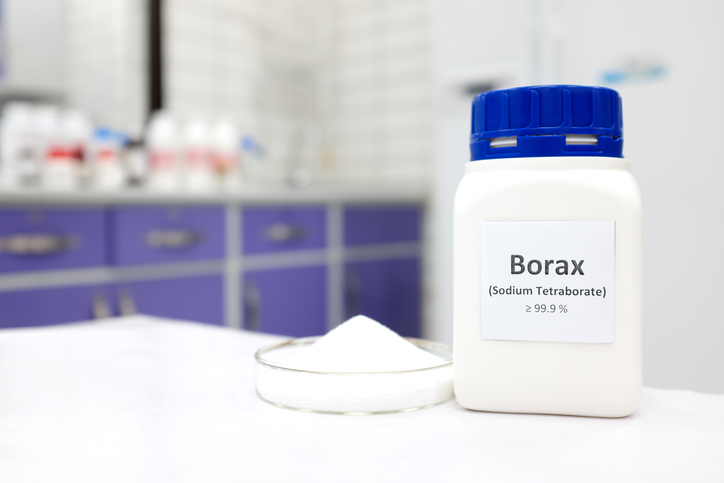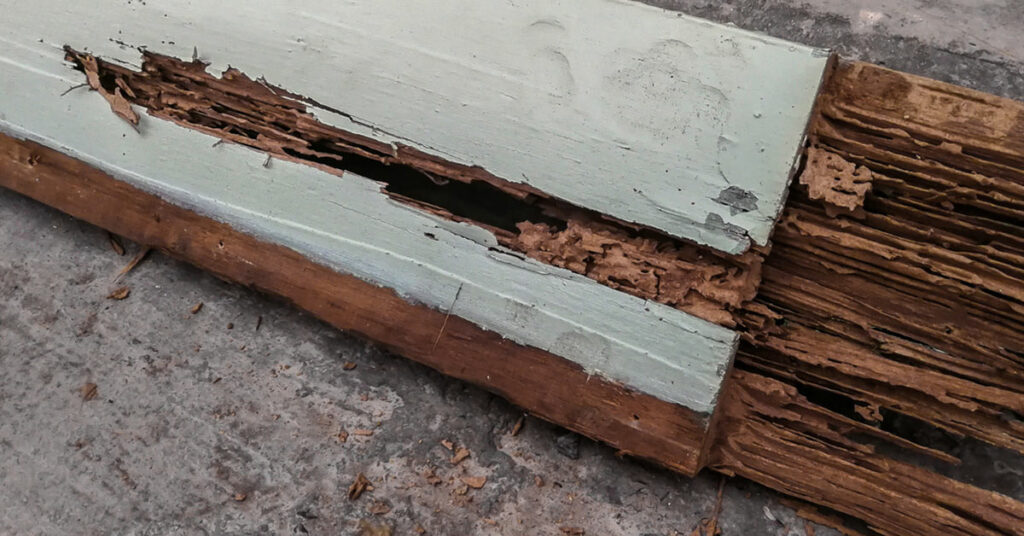Do Ants Cause Structural Damage?
Yes, ants can cause structural damage, particularly carpenter ants, which are known for their ability to excavate wood to create their nests. Unlike termites, carpenter ants do not eat wood but remove it to expand their living areas, potentially weakening the structural integrity of buildings over time. While not all ant species pose a threat to structures, identifying and addressing a carpenter ant infestation early is crucial to prevent significant damage. Homeowners should watch for signs like sawdust-like shavings and large, winged ants, which indicate the presence of these wood-damaging pests.
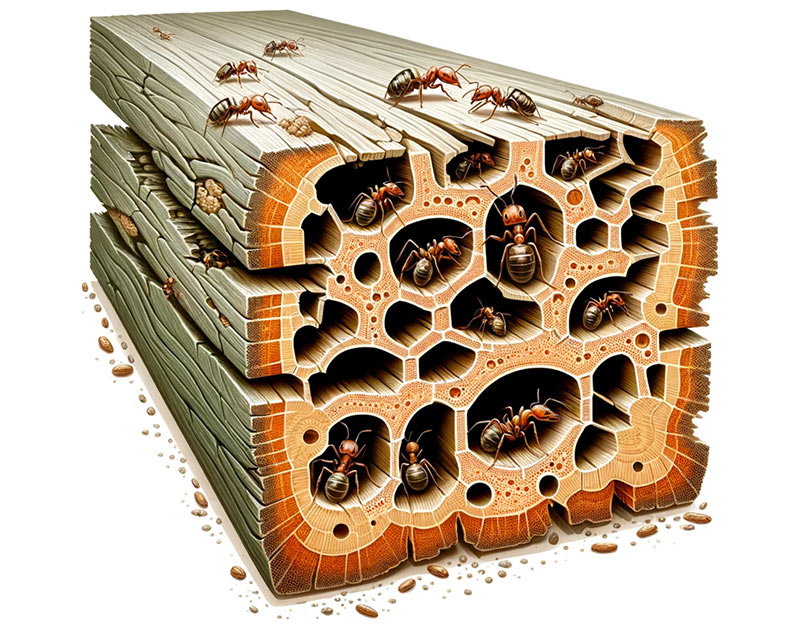
Ants: A Tiny Menace in Our Homes
Often perceived as mere nuisances, ants can represent a significant threat to our homes, going beyond the occasional kitchen invasion. While many species coexist with humans harmlessly, others, like carpenter ants, pose a real danger to the structural integrity of our living spaces. This article delves into the multifaceted impact of ant infestations, exploring their behavior, the potential for structural damage, and the broader implications for homeowners.
Ants are among the most common household pests worldwide, with thousands of species exhibiting diverse behaviors and habitats. While some are simply attracted to food sources within our homes, others, like the carpenter ant, seek out moist, decaying wood to establish their colonies. These habits can lead to significant structural damage if left unchecked.
The financial implications of such infestations are not to be underestimated. From the cost of extermination to the expenses involved in repairing structural damage, homeowners can find themselves facing hefty bills. Moreover, the presence of ants can also raise health concerns, ranging from allergic reactions to the spread of contaminants.
This article aims to provide a comprehensive overview of the challenges posed by ants, particularly focusing on home infestations, structural damage, and the associated costs and health risks. Drawing from a range of sources, including expert interviews, case studies, and the latest research, we offer both technical insights and practical advice. Our goal is to equip readers with the knowledge needed to effectively address and prevent these common yet often underestimated pests.
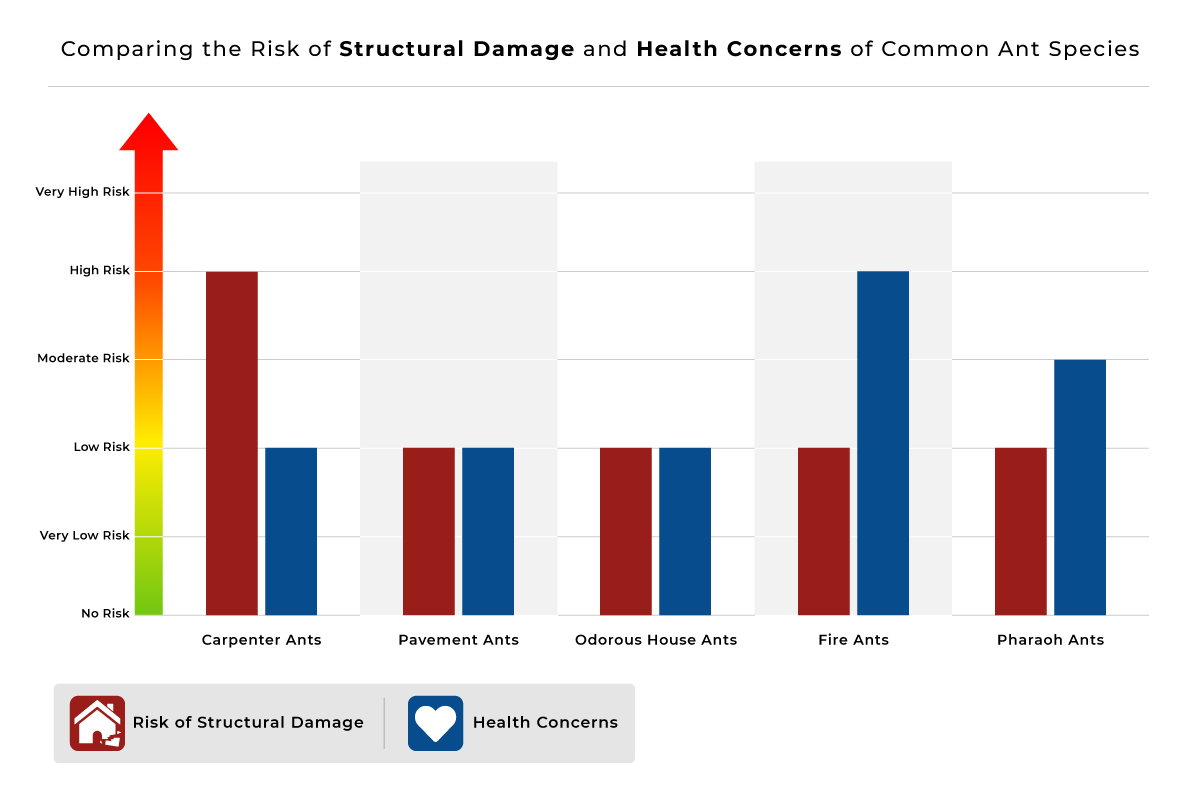
Comparing Ant Species and Their Impact on Homes
Carpenter Ants
- Size: Large
- Color: Black, Reddish
- Preferred Habitat: Moist, decaying wood
- Risk of Structural Damage: High
- Health Concerns: Low
- Prevention Tips: Manage moisture, repair damaged wood, professional inspection
Pavement Ants
- Size: Small
- Color: Dark Brown
- Preferred Habitat: Under stones, pavement cracks
- Risk of Structural Damage: Low
- Health Concerns: Low
- Prevention Tips: Seal entry points, keep areas clean
Odorous House Ants
- Size: Small
- Color: Dark Brown, Black
- Preferred Habitat: Near moisture sources
- Risk of Structural Damage: Low
- Health Concerns: Low
- Prevention Tips: Eliminate food sources, seal cracks, maintain cleanliness
Fire Ants
- Size: Medium
- Color: Reddish Brown
- Preferred Habitat: Lawns, open sunny areas
- Risk of Structural Damage: Low
- Health Concerns: High (stings)
- Prevention Tips: Use bait treatments, maintain lawn health
Pharaoh Ants
- Size: Very Small
- Color: Light Yellow
- Preferred Habitat: Warm, humid areas
- Risk of Structural Damage: Low
- Health Concerns: Moderate (disease vectors)
- Prevention Tips: Use bait stations, professional control for large infestations
Home Infestations and Structural Damage: A Closer Look
Ant infestations in homes are more than just a nuisance; they can lead to serious structural damage, depending on the species. Among the various types, carpenter ants are particularly notorious for their ability to compromise the integrity of wooden structures.
Understanding Carpenter Ants
Carpenter ants, unlike termites, do not consume wood but excavate it to create their nests. These ants are attracted to moist, decaying wood, often found in older homes or buildings with water damage. The pest control manual emphasizes that these ants can also nest in dry, sound wood, expanding their potential for widespread damage.
Identifying Infestation Signs
The first step in addressing an ant infestation is recognizing its signs. Homeowners might notice fine wood shavings, similar to sawdust, beneath wooden items – a clear indicator of carpenter ant activity. Another sign is the presence of large, winged ants emerging from crevices in the home, especially in spring. These are reproductive ants leaving the nest to start new colonies.
Extent of Damage
The extent of damage caused by carpenter ants can vary. In the early stages, it might be minimal, but over time, as the colony grows, so does the damage. Large colonies can significantly weaken wooden structures, leading to costly repairs. In severe cases, the structural integrity of a building can be compromised, posing safety risks.
It is fairly uncommon for carpenter ants to infest homes, but it is highly likely that you have carpenter ants in your yard if you have large older trees present.
Remediation Strategies
Effective remediation involves a combination of mechanical and chemical strategies. Locating and destroying the nest is crucial. Pest control professionals often use specialized equipment to locate nests hidden within structures. Once located, nests can be treated with insecticides. Additionally, moisture control and wood repair are essential steps in preventing future infestations.
Preventive Measures
Prevention is always better than cure. Regular inspections for signs of moisture damage or wood decay can help in early detection. Ensuring proper ventilation in crawl spaces, attics, and basements reduces moisture accumulation, making the environment less attractive to carpenter ants.
Cost Implications of Ant Infestations: A Comprehensive Analysis
When it comes to ant infestations, particularly those involving species like carpenter ants, the financial implications can be substantial and multifaceted. Homeowners may face expenses related to extermination, structural repairs, and ongoing preventive measures.
Here is a general overview of the costs associated with different types of ant remediation services. It’s important to note that these prices can vary based on location, severity of the infestation, and specific service provider.
| Service Type | Approximate Price Range |
|---|---|
| 1. Initial Inspection | $100 – $250 |
| 2. Standard Ant Treatment | $150 – $300 |
| 3. Carpenter Ant Treatment | $500 – $1,000+ |
| 4. Ongoing Maintenance/Prevention | $300 – $800 annually |
| 5. Advanced/Eco-Friendly Options | $800 – $2,000 |
| 6. Additional Services (Repair/Restoration) | Variable (potentially thousands) |
1. Initial Inspection
Before any treatment, a professional inspection is often necessary to determine the extent of the infestation and the appropriate course of action. The cost for this inspection typically ranges from $100 to $250, depending on the size of the property and the complexity of the infestation.
2. Standard Ant Treatment
For a basic ant infestation, standard treatment methods like sprays and baiting systems are commonly used. These services can cost between $150 to $300. This treatment is usually effective for common ant species and minor infestations.
3. Carpenter Ant Treatment
Treating carpenter ants, known for causing structural damage, often requires more specialized and extensive methods. The cost for carpenter ant treatment can range from $500 to $1,000 or more, depending on the infestation’s severity and the treatment’s complexity.
4. Ongoing Maintenance and Prevention
To prevent re-infestation, many homeowners opt for ongoing maintenance services. These can include regular inspections and treatments, typically offered as part of a yearly plan. Such plans can cost between $300 to $800 annually, providing peace of mind and continuous protection against ants.
5. Advanced and Eco-Friendly Options
For severe infestations or those requiring eco-friendly solutions, advanced treatment options like heat treatments or extensive baiting and monitoring systems are available. These methods can be more costly, ranging from $800 to $2,000, depending on the technology used and the infestation’s scope.
6. Additional Services
In cases where ants have caused significant structural damage, additional services such as repair and restoration may be necessary. While the costs for these services vary greatly based on the damage extent, they can easily run into thousands of dollars.
Extermination Costs
The cost of professional extermination can vary widely depending on the severity of the infestation, the size of the property, and the location. For a standard treatment, homeowners might expect to pay anywhere from a few hundred to several thousand dollars. This cost can increase significantly if the infestation is extensive or if multiple treatments are required. Additionally, if the infestation has spread to multiple areas or involves hard-to-reach nests, the cost of extermination can escalate.
Structural Repair Costs
Carpenter ants, in particular, pose a risk of structural damage due to their nesting habits in wood. The cost of repairing this damage can be considerable. If the infestation is caught early, repairs might be limited to replacing a few sections of damaged wood. However, in cases of long-term infestation, the structural integrity of the building can be compromised, necessitating extensive and costly repairs. This can include replacing significant portions of wooden structures, such as beams, joists, and even foundational elements, which can run into tens of thousands of dollars.
On the structural threat of carpenter ants:
“Carpenter ants can do considerable damage structurally, and it may be necessary to replace timbers.”
– Desiree Straubinger,
Board-Certified Entomologist and Market Technical Director for Ehrlich Pest Control
Preventive Measures and Maintenance
Investing in preventive measures can also contribute to the overall cost. This includes regular pest control services, which can range from periodic inspections to more comprehensive maintenance plans. Homeowners might also need to invest in home improvements to prevent future infestations, such as improving drainage, fixing leaks, replacing rotting wood, and sealing entry points. These preventive measures, while initially costly, can save money in the long run by avoiding more severe infestations and damage.
Indirect Costs
Beyond the direct costs of extermination and repairs, there are indirect costs to consider. These can include temporary accommodation if the home requires extensive treatment or repair, loss of property value due to known infestation history, and even potential health costs if the infestation leads to allergic reactions or other health issues.
Insurance Considerations
It’s important to note that most homeowners’ insurance policies do not cover damage caused by pests like ants. This means that all costs related to extermination and repairs will likely be out-of-pocket expenses for the homeowner.
Health Concerns
Beyond structural damage, ants pose health risks to humans and pets. Some species, like fire ants, can inflict painful stings, which are dangerous to individuals with allergies. The manual emphasizes the importance of identifying the ant species to tailor control methods effectively, reducing health risks.
Practical Advice for Homeowners: Managing and Preventing Ant Infestations
Dealing with ant infestations, particularly those that pose a risk of structural damage, requires a combination of vigilance, preventive measures, and effective treatment strategies. Here’s a comprehensive guide for homeowners to manage and prevent ant infestations:
Early Detection
- Regular Inspections: Conduct regular inspections of your home, especially in areas prone to moisture, such as bathrooms, kitchens, basements, and around windows.
- Identify Signs Early: Look for signs like sawdust-like debris (frass), hollow-sounding wood, and visible ant trails.
“Usually the wood they build their nests in is already damaged. Often, the wood is wet, moldy, or rotting in some capacity.”
– Roberto M. Pereira, Ph.D. on the nesting habits of carpenter ants
Research Scientist with the University of Florida
Home Maintenance and Repairs
- Address Moisture Issues: Fix leaks, ensure good ventilation, and use dehumidifiers in damp areas to reduce moisture that attracts ants.
- Seal Entry Points: Caulk cracks and crevices in walls, foundations, and around windows and doors.
Repair Damaged Wood: Replace any decayed or damaged wood promptly to eliminate potential nesting sites.
Sanitation and Housekeeping
- Keep It Clean: Regularly clean crumbs and spills, especially in the kitchen, to avoid attracting ants.
- Proper Food Storage: Store food in airtight containers and dispose of garbage regularly.
- Trim Vegetation: Keep trees and shrubs trimmed away from the house to prevent ants from using them as bridges.
ON CARPENTER ANT DIET:
“Carpenter ants typically eat insects, meats, pet food, syrup, honey, sugar, jelly, and other things that are sweet. They’ll feed on pretty much anything they can find, depending on how hungry they are.”
Natural and Chemical Ant Control
- Natural Deterrents: Use natural deterrents like vinegar, lemon juice, or peppermint oil in areas where ants are seen.
- Bait Stations: Place ant bait stations near entry points to eliminate the colony.
- Professional Pest Control: For severe infestations, especially with carpenter ants, consider hiring a professional pest control service.
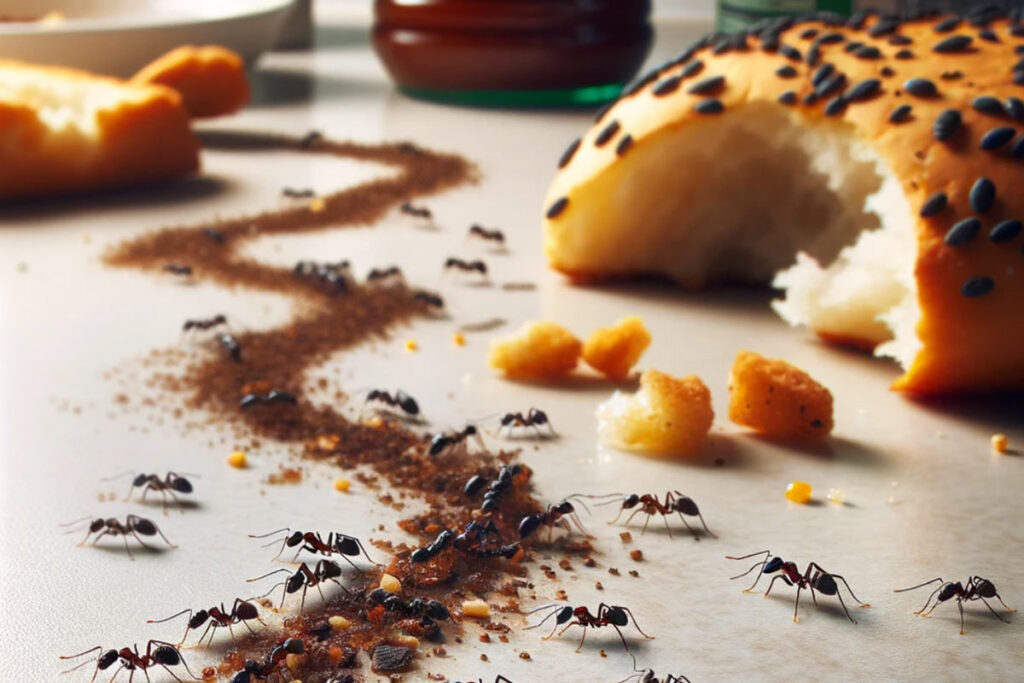
Ongoing Monitoring and Prevention
- Regular Monitoring: Even after treatment, continue to monitor your home for signs of ant activity.
- Preventive Treatments: Consider periodic preventive treatments, especially in areas previously affected by ants.
- Stay Informed: Keep up-to-date with the latest methods and products for ant control and prevention.
Landscaping and Outdoor Management
- Manage Yard Debris: Regularly clear away dead wood, leaf litter, and other debris from your yard.
- Control Moisture Outside: Ensure proper drainage away from your home’s foundation.
- Inspect Outdoor Furniture and Structures: Regularly check decks, porches, and outdoor furniture for signs of ant activity.
Conclusion
The threat posed by ants, particularly species like carpenter ants, underscores a critical aspect of home maintenance and health safety. While often underestimated, these tiny invaders can lead to significant structural damage, financial burdens, and health concerns. Understanding the behavior of ants, recognizing the signs of infestation, and taking timely action are key to mitigating these risks.
Homeowners should adopt a proactive approach to pest control. Regular inspections for signs of moisture damage, decay, or ant activity can help in early detection, preventing extensive damage. Simple preventive measures, such as sealing entry points, managing moisture, and maintaining cleanliness, can be effective in deterring ant infestations.
When dealing with an infestation, identifying the ant species is crucial for effective treatment. While DIY methods can be useful for minor problems, professional pest control services are often necessary for more severe or persistent infestations, especially those involving carpenter ants. The costs for these services, although potentially significant, are investments in the longevity and safety of one’s home.
The health implications of ant infestations, though less direct, are equally important. Certain ant species can cause allergic reactions or exacerbate existing health conditions. Ensuring a pest-free environment contributes to the overall well-being of the household.
In conclusion, ants, while small, can lead to large-scale problems if ignored. The importance of proactive measures in preventing and addressing ant-related damage and health concerns cannot be overstated. Homeowners equipped with the right knowledge and resources can effectively manage these pests, safeguarding both their homes and health. Remember, the key to controlling ant infestations lies not just in reaction, but in prevention and early intervention.
FAQ: Ants and Structural Damage
Do ants cause structural damage to buildings?
Yes, certain ant species, particularly carpenter ants, can cause structural damage. They excavate wood to create their nests, which can weaken the structural integrity of buildings over time.
How can I tell if ants are causing damage to my home?
Signs of ant-related damage include sawdust-like shavings, hollow-sounding wood, and visible tunnels or galleries in wooden structures. Large, winged ants emerging from crevices can also indicate an infestation.
Are carpenter ants the only ants that cause structural damage?
While carpenter ants are the most notorious for causing structural damage due to their wood-excavating habits, other species may indirectly cause damage by attracting moisture or other pests.
Can ant infestations lead to other problems in the home?
Yes, besides structural damage, ant infestations can lead to health concerns like allergies and can attract other pests. They can also contaminate food sources.
What are the best ways to prevent ant infestations?
Preventive measures include sealing cracks and entry points, managing moisture levels, keeping the home clean, and removing potential food sources. Regular inspections can also help detect early signs of infestation.
Should I handle an ant infestation myself or call a professional?
For minor infestations, DIY methods might suffice. However, for larger or more persistent infestations, especially those involving carpenter ants, professional pest control services are recommended.
How much does it cost to repair damage caused by ants?
The cost varies depending on the extent of the damage. Minor repairs may cost a few hundred dollars, while extensive damage requiring structural repairs can run into thousands.
Are there any natural remedies effective against ants?
Natural remedies like vinegar, lemon juice, and essential oils can deter ants but may not be effective for eliminating an infestation, especially one involving carpenter ants.
Can ants damage electrical wiring or plumbing?
While not common, some ant species have been known to damage electrical wiring or insulation. They generally do not damage plumbing but may exploit existing leaks or moisture.
How long does it take for ants to cause significant damage?
The time frame varies depending on the species and the conditions. Carpenter ants can cause noticeable damage within a year, but significant structural damage might take several years to develop.




